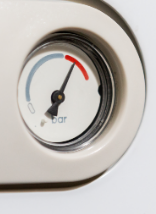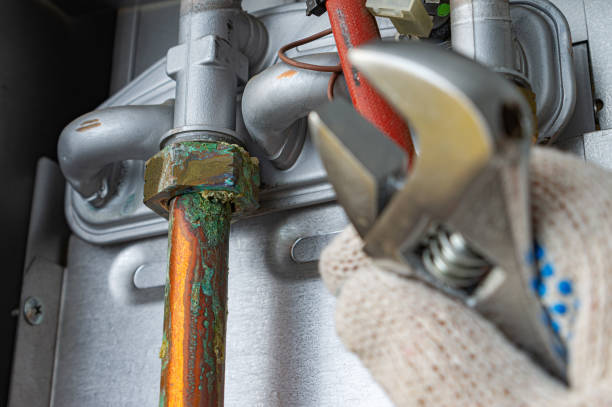Boiler pressure gauges are essential tools to monitor the pressure levels in a boiler system. Understanding how to read a boiler pressure gauge accurately can help you identify potential problems and prevent costly breakdowns. In this article, we will guide you through the steps to read a boiler pressure gauge correctly.
What should boiler pressure be?
Most manufacturers recommend an ideal pressure for combi boiler systems between 1bar and 2bar. Maintaining this pressure level is crucial for optimal performance and safety. Low pressure can cause poor heating performance and increase the risk of damage to the boiler, while high pressure can damage the system and cause the pressure relief valve to open.
Locate the pressure gauge on the front or side of the boiler to read the pressure level. The needle or pointer indicates the current pressure level, which should be within the safe operating range usually coloured green. Outside of this zone indicates too low or too high pressure.
Regularly check the pressure level to detect potential problems promptly. This applies to both analogue and digital displays. Ensuring the ideal pressure level is maintained is essential for proper functioning and to prevent potential damage or safety hazards.

How to Read a Boiler Pressure Gauge
Step 1: Locate the Pressure Gauge
The first step in reading a boiler pressure gauge is to locate it. The pressure gauge is usually located on the boiler and is mounted on the front or side of it, and will look something like the image above or will be on the digital display in modern boilers.
Step 2: Read the Pressure Level
To read the pressure level, you need to look at the pressure gauge and find the needle or pointer. The needle or pointer indicates the current pressure level in the boiler system. The pressure level should be within the safe operating range indicated on the pressure gauge. This is usually the green coloured area.
On boilers with a digital display, you will need to press the relevant button to find the pressure level, refer to the user manual for help.
Step 3: Check the Pressure Level Regularly
It is recommended to check the pressure level in the boiler system regularly to ensure it is within the safe operating range. A sudden increase or decrease in pressure can indicate a potential problem and should be addressed promptly.

Maximize Boiler Efficiency with a Pressure Gauge
Understanding Boiler Pressure
The pressure level in a boiler system is an indicator of its efficiency. The ideal pressure level for a boiler system is between 0.8 and 1.5 bar combi boilers. Maintaining the pressure level within this range can help maximise boiler efficiency and prevent potential problems.
Boiler pressure is an important factor that affects the efficiency and performance of a boiler system. The pressure level in the boiler system is a measure of the amount water that is being stored and is used to transfer heat to the heating system.
Understanding boiler pressure is crucial in order to ensure that the boiler is operating at peak efficiency and that the system is functioning safely.
If the pressure level in the boiler system is too low, it can cause the boiler to work harder, leading to increased fuel consumption and reduced efficiency. On the other hand, if the pressure level is too high, it can cause the boiler to become overworked and lead to potential problems and breakdowns. Both extremes can lead to component failure.
Importance of Monitoring Pressure
Monitoring the pressure level in a boiler system is crucial in order to maintain efficient and safe operation. Regular monitoring of pressure levels allows you to identify potential issues early on, and make necessary adjustments to ensure that the system is functioning correctly.
There are several reasons why it is important to monitor the pressure level in a boiler system:
- Safety: Maintaining the pressure level within the safe operating range is essential to ensure the safety of the boiler system. If the pressure level becomes too high, it can cause the boiler to overwork and potentially lead to a boiler breakdown.
- Efficiency: If the pressure level is too low, it can cause the boiler to work harder, leading to higher fuel usage and reduced efficiency.
- Cost savings: By monitoring the pressure level, you can identify potential issues early on and make necessary adjustments, which can help you to save money on energy costs and prevent costly repairs.
- Maintenance: Regular monitoring of pressure levels can help you to identify any potential issues before they become major problems, allowing you to schedule maintenance and repairs when needed.

How a Boiler Pressure Gauge Works
The pressure gauge works by measuring the pressure of the water in the boiler system and converting it into a readable format, typically in millibars (mbar). The gauge usually has a dial that displays the pressure level, and a needle that indicates the current pressure level. Modern boilers display the readings digitally.
The pressure level is indicated on the gauge using a needle or pointer, and the safe operating range is indicated on the pressure scale. The gauge is typically mounted on the front of the boiler and is connected to the system through a pipe.
The gauge works by using a pressure sensitive diaphragm that is connected to the needle. As the pressure in the boiler system changes, the diaphragm expands or contracts, causing the needle to move and indicating the corresponding pressure level on the dial.
Checking Pressure Regularly
To ensure that your boiler system is operating at peak efficiency, it is recommended to check the pressure level regularly using a boiler pressure gauge. A sudden increase or decrease in pressure can indicate a potential problem and should be addressed promptly.
The frequency of pressure checks will vary depending on the type of boiler system and the conditions in which it is being used. As a general guideline, it is recommended to check the pressure level at least once a month.
To check the pressure level, simply look at the dial on the boiler pressure gauge. If the pressure level is within the safe operating range, there is no need to take any action. If the pressure level is too low, you can add water to the system to increase the pressure level.
A boiler system deals with too high pressure by releasing some of the pressure through a safety device called a pressure relief valve. The pressure relief valve is designed to automatically open and release pressure when the pressure level in the boiler exceeds a certain limit, typically above 3 bar.
When the pressure relief valve opens, it releases some of the pressure in the form of water, which helps to reduce the pressure level back to a safe level. The pressure relief valve is typically located inside the boiler and accessible for maintenance and inspection by gas engineers.
If the pressure relief valve is not working correctly, it can lead to dangerous overpressure situations and potential damage to the boiler.
If you suspect the pressure relief valve is faulty or if the pressure level in the boiler is consistently too high, it is important to seek professional help from a qualified engineer.
Boiler pressure too low?
A boiler normally loses pressure once or twice a year. But a sudden pressure loss is a problem. The main causes of pressure loss are water leaks in the system. Check under the boiler and pipework for signs of leaking. A faulty pressure relief valve will also cause the boiler to keep losing pressure, check for water being discharged from the pipe outside.
Read the full article about this here
What should boiler pressure be when heating is off?
Boiler pressure between 0.75 and 1.5 bar is correct when central heating is turned off. Boilers have a green zone marked on the pressure gauge where the needle should stay within at all times. Don’t let it go below this level. The user manual for the boiler will tell you exactly what they consider low pressure.
Actions you can take if boiler pressure is low
If the pressure in your boiler system is low, there are a few steps you can take to address the issue:
- Add water: If the pressure is low, it is likely that the system needs more water. You can add water to the system by locating the filling loop and using the valve to add water to the system until the pressure gauge reads the recommended pressure level.
- Check for leaks: A low pressure level can also be a sign of a leak in the system. Check for visible signs of leaks, such as dripping from pipes or valves, and repair any leaks that you find.
- Check the pressure relief valve: The pressure relief valve can sometimes become stuck, which can prevent the system from building up pressure. Check the pressure relief valve to ensure that it is functioning correctly and is not stuck. You will need a qualified engineer to do this. They should also check the expansion vessel at the same time.

How can boiler pressure become high
There are several reasons why the pressure in a boiler system can become high:
- Overfilling: If too much water is added to the system, it can cause the pressure to become too high. Overfilling can occur if the system is manually topped up or if the pressure relief valve becomes stuck in the closed position.
- Leaks: If there is a leak in the system, it can cause the pressure to become too high as the water level decreases. This can also cause the expansion vessel to become system. If the vessel becomes damaged or fails, it can result in high pressure.
- Stuck pressure relief valve: The pressure relief valve is designed to open and release pressure if the pressure becomes too high. If the valve becomes stuck, it can prevent the pressure from being released, which can cause the pressure to become too high.
- Faulty circulator pump: The circulator pump helps to circulate water through the system. If the pump becomes damaged or malfunctions, it can cause the pressure to become too high.
Conclusion
A boiler pressure gauge is a valuable tool for monitoring the pressure levels in a boiler system. By understanding the importance of monitoring pressure and how a boiler pressure gauge works, you can maximise boiler efficiency and prevent costly breakdowns.
Regularly checking the pressure level using a boiler pressure gauge is the key to keeping your boiler system operating at peak efficiency

